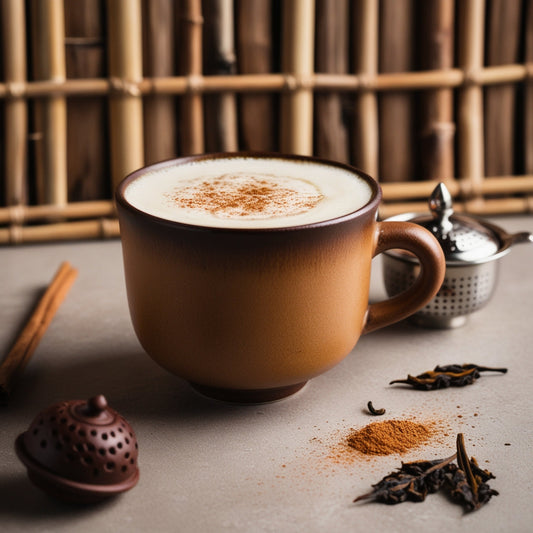Introduction
Are you intrigued by the world of tea and eager to explore a variety that offers unique flavours and centuries-old traditions? Let us introduce you to Pu-erh tea, a remarkable fermented tea from China's Yunnan province that captivates tea enthusiasts worldwide. Made from the special Yunnan big leaf variety of the Camellia sinensis plant, Pu-erh tea differentiates itself through a fascinating fermentation process. Whether you are a seasoned tea connoisseur or just starting your journey, understanding the distinct qualities of raw and ripe Pu-erh tea, How it tastes and its Health Benefits.
Table of Content
- Introduction
- What is Pu-erh Tea
- How to store Pu-erh tea
- Conclusion
What is Pu-erh Tea
Pu-erh tea is made from a special variety of the Camellia sinensis plant known as Yunnan big leaf. Pu-erh tea differentiates based on fermentation. Raw Pu-erh typically has a stronger green vegetal flavour and is generally bitter. Ripe Pu-erh is generally earthy. The journey of Pu-erh tea begins with the careful selection and harvesting of the tea leaves. The tea leaves undergo withering a process that reduces their moisture content.
Fermentation
Sheng Pu-erh (Raw) undergoes natural fermentation through a slow aging process. Tea leaves are harvested and withered, then pan-fired to stop oxidation. The leaves are then pressed into cakes and stored in a controlled environment. Over years or decades, natural microbial activity gradually transforms the tea's flavour and character. This method preserves the tea's original qualities while allowing it to develop complex, earthy notes over time.
Health Benefits
Pu-erh tea can help reduce body fat and lower cholesterol levels. The fermentation process produces compounds that can enhance fat metabolism. Additionally, Pu-erh tea can aid in digestion, making it easier for the body to process and eliminate fats.The fermentation process increases the production of beneficial probiotics, which can help balance the gut micro bacteria. Regular consumption of Pu-erh tea has been linked to improved cardiovascular health. The tea contains antioxidants such as catechins and flavonoids, which can reduce oxidative stress and inflammation.
Taste
Taste profile transforms from one flavour to another between brews of the same tea, or one may experience a bouquet of flavours within a single brew. Many Pu-erh enthusiasts agree that the best taste is obtained around the 4th or 5th brew, when the leaves fully unfurl and release their flavors.
Routine
The higher tea polyphenols in raw Pu-erh tea may cause insomnia, so it’s best not to drink tea two hours before bedtime, especially new tea.

Cultural Significance
Pu-erh tea holds deep cultural importance, especially in China, where it originates. In the Yunnan province, where Pu-erh tea comes from, locals have valued it for its medicinal properties and its role in daily life. Traders bartered Pu-erh tea for horses on the Tea Horse Roads, highlighting its economic significance. Traditional Chinese medicine often associates this tea with aiding digestion, reducing cholesterol, and promoting weight loss.
Pharmacological Elements
Pu-erh contains elements like Vitamins B1, B2 C and E, potassium, phosphorous, calcium, magnesium, aluminium, lysine, arginine, histidine and cystine, linoleic and linolenic acids and trace amounts of zinc, sodium, nickel, iron, beryllium, sulphur and fluorides.

Brewing Process
Here are the steps included in brewing process. Measure three grams of tea for every 6 oz of water. Pour water at 208-212 degrees Fahrenheit over the leaves and steep for 10-20 seconds, and then pour off the water. This process, called rinsing the leaves, removes impurities and allows the leaves to begin opening. Next, pour another 6 oz of water at 208-212 degrees Fahrenheit, steep for about 30 seconds, and serve. You can re-steep the same leaves 4-8 times in a similar fashion, adding 15-30 seconds to each steeping time.
How to Store Pu-erh Tea?
To preserve Pu-erh tea, store it in a cool, dry place away from direct sunlight. Use breathable containers like clay jars, bamboo wrappers, or paper boxes to allow airflow. Maintain a stable temperature and avoid rapid changes to protect the tea's integrity. Ensure moderate humidity, around 60-70%, to prevent mould while keeping the tea from becoming too dry. Proper storage will enhance the aging process and improve the tea's flavour over time.
Conclusion
Exploring the world of Pu-erh tea offers a unique journey into rich flavours, centuries-old traditions, and remarkable health benefits. From understanding the fermentation process that differentiates raw and ripe Pu-erh to appreciating the cultural significance and proper brewing techniques, Pu-erh tea opens up a delightful and enriching tea experience.
Ready to embark on your Pu-erh tea adventure? Start by trying some high-quality Pu-erh tea from Puerh Craft. Experience the depth of flavours and the soothing benefits of this exceptional tea. Don't wait—immerse yourself in the fascinating world of Pu-erh tea today!
Q&A
Q. What differentiates Pu-erh tea from other types of tea?
A. Pu-erh tea stands out due to its unique fermentation process and its origin from the Yunnan big leaf variety of the Camellia sinensis plant. This fermentation process creates two types of Pu-erh tea: raw (Sheng) and ripe (Shou).
Q. How is Sheng Pu-erh (raw) tea processed?
A. Sheng Pu-erh undergoes natural fermentation through a slow aging process. Harvesters pick the tea leaves, wither them, and then pan-fire them to stop oxidation. They then press the leaves into cakes and store them in a controlled environment, where natural microbial activity over years or decades gradually transforms the tea's flavor and character, preserving its original qualities while developing complex, earthy notes over time.
Q. What are some of the health benefits associated with Pu-erh tea?
A. People believe that Pu-erh tea aids digestion, reduces cholesterol, and promotes weight loss. It contains various vitamins (B1, B2, C, E), minerals (potassium, phosphorous, calcium, magnesium), and trace elements. These components contribute to its health-promoting properties and its long-standing use in traditional Chinese medicine.
Q. What is the best method for brewing Pu-erh tea?
A. To brew Pu-erh tea, measure three grams of tea for every 6 oz of water. Pour water at 208-212 degrees Fahrenheit over the leaves and steep for 10-20 seconds, then pour off the water to rinse the leaves. Next, pour another 6 oz of water at the same temperature, steep for about 30 seconds, and serve.
Q. How to store Pu-erh tea to maintain its quality?
A. To preserve Pu-erh tea, store it in a cool, dry place away from direct sunlight. Use breathable containers like clay jars, bamboo wrappers, or paper boxes to allow airflow. Maintain a stable temperature and avoid rapid changes to protect the tea's integrity. Ensure moderate humidity, around 60-70%, to prevent mold while keeping the tea from becoming too dry. Proper storage enhances the aging process and improves the tea's flavor over time.






